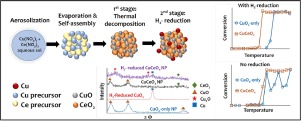Journal of the Taiwan Institute of Chemical Engineers ( IF 5.5 ) Pub Date : 2018-02-27 , DOI: 10.1016/j.jtice.2018.01.049 Chih-Yuan Lin , Fang-Chun Chou , De-Hao Tsai

|
The synergistic effect of CuCe
O hybrid nanostructure has shown the promise for catalytic methane combustion. In this study, we develop an aerosol-based two-stage thermal treatment method to (1) synthesize the Cu
Ce
O hybrid nanoparticle (NP) with a tunable oxidation state directly in gas phase, and (2) provide a mechanistic understanding of surface reduction of the Cu
Ce
O hybrid NP for catalysis of methane combustion. After evaporation-induced self-assembly followed by a thermal decomposition to form metal oxide NP at the 1st stage thermal treatment, a temperature-programmed, aerosol-based hydrogen reduction process was employed for direct tuning the oxidation state of the NP in the gas phase (the 2nd stage thermal treatment). Differential mobility analysis, x-ray diffractomery, x-ray photoelectron spectroscopy, and scanning electron microscopy were employed complementarily for characterization of particle size, morphology, crystallinity, elemental composition, and oxidation state of the NPs. The results show a successful surface reduction of Cu for both Cu-only NP and Cu
Ce
O hybrid NP by the aerosol-based two-stage thermal treatment method. Using the Cu
Ce
O hybrid nanoparticle as catalyst, our results show a successfully catalysis on methane combustion over various initial oxidation states of Cu. The results show a high activity with a low light-off temperature, a high light-off stability and operation stability toward catalytic methane combustion. The prototype method proposed in this study provides the mechanistic understanding of the synergistic catalysis of the surface-reduced Cu
Ce
O hybrid nanoparticle with different oxidation states. The method can be especially useful to fabricate a variety of nanocatalysts with different oxidation states of active metals by design for the study of methane-based energy and environmental applications (e.g., CO2 dry reforming by methane).
中文翻译:

Cu
Cu Ce
O杂化纳米结构的协同效应显示了催化甲烷燃烧的希望。在这项研究中,我们开发了一种基于气溶胶的两阶段热处理方法,以(1)直接在气相中合成具有可调氧化态的Cu
Ce
O杂化纳米颗粒(NP),以及(2)提供对表面的机械理解还原铜
铈
O杂化NP用于催化甲烷燃烧。在蒸发诱导的自组装之后,在第一步热处理中进行热分解以形成金属氧化物NP之后,采用了基于程序的基于气溶胶的氢还原工艺,可以直接调节气相中NP的氧化态(第二阶段热处理)。差分迁移率分析,X射线衍射,X射线光电子能谱和扫描电子显微镜被互补地用于表征NP的粒径,形态,结晶度,元素组成和氧化态。结果表明,通过基于气溶胶的两阶段热处理方法,仅纯铜纳米颗粒和Cu
Ce
O杂化纳米颗粒都成功地还原了Cu 。使用铜
铈
以杂化纳米粒子为催化剂,我们的结果表明在Cu的各种初始氧化态下,甲烷燃烧均能成功催化。结果显示出高活性,低起燃温度,高起燃稳定性和对甲烷催化燃烧的操作稳定性。本研究提出的原型方法提供了对具有不同氧化态的表面还原Cu
Ce
O杂化纳米粒子协同催化的机理的理解。通过设计用于研究基于甲烷的能源和环境应用(例如,通过甲烷进行的CO 2干重整)的研究,该方法对于制造具有不同活性金属氧化态的多种纳米催化剂尤其有用。











































 京公网安备 11010802027423号
京公网安备 11010802027423号